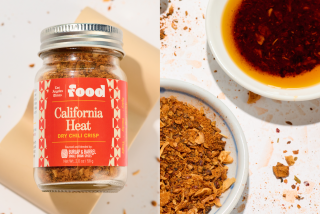Smoky, Dark Ancient Catsup
- Share via
JAKARTA, Indonesia — It’s a familiar scene: a sweltering summer day, a picnic table outdoors, a waitress serving up paper plates piled with meat sizzling hot off the grill. I do what millions of hungry eaters would do under these circumstances: I reach for a bottle of catsup.
But wait. What emerges from the bottle is the color of ebony and the consistency of molasses. It tastes like a cross between soy sauce and brown sugar, with a generous whiff of ginger and garlic.
Well, it’s certainly not tomato catsup, but believe it or not, it shares a common ancestor with the American condiment. This is kecap manis (pronounced kuh-CHOP MAH-neece).
The story begins at least five centuries ago in southern China, where the people of Amoy (now called Xiamen) seasoned their food with the brine from pickled anchovies or shellfish. They called this condiment ke-tsiap--the ancestor of our word “catsup.” Devotees of Southeast Asian cuisines will recognize it as fish sauce, the equivalent of the Thai nam pla or Vietnamese nuoc nam.
The Amoy Chinese spread through Southeast Asia, taking their sauce with them. English seafarers encountered ke-tsiap in what is now Malaysia in the 17th century. (“A high East-India Sauce” is how one chronicler described it in 1690.) The sailors liked it so much they took samples home.
Soon British chefs were trying to duplicate the flavor of ke-tsiap, using local ingredients such as walnuts and mushrooms. Walnut and mushroom catsups--rather resembling Worcestershire sauce--are still made in England.
In Europe, the idea of catsup quickly evolved into something quite unlike the original. To get an idea of how different catsup was 200 years ago, consider the following recipe, offered by Elizabeth Raffald in her 1778 cookbook, “The Experienced English House-Keeper”:
“Take two quarts of the oldest strong beer you can get, put to it one quart of red wine, three quarters of a pound of anchovies, three ounces of shallots peeled, half an ounce of cloves, three large races of ginger [ginger roots] cut in slices. Boil all together over a moderate fire, till one third is wasted [reduced by 1/3], the next day bottle it.” Incidentally, Raffald guaranteed that her catsup would keep for seven years.
There was still a fish element in 1778, but drop the anchovies (and the beer), change the wine to vinegar and add sugar, and the only thing missing for this to be tomato catsup was the tomatoes. That last step was taken in the mid-19th century.
Perhaps the Indonesians themselves had already changed the original fish sauce condiment. Certainly the modern-day kecap is about as far from nam pla as our tomato catsup is. It’s basically soy sauce with added flavorings.
One is palm sugar, a sticky, fudge-like, tan-colored sweetener with a rich, malty caramel flavor. Palm sugar gives kecap manis its sweetness and thick consistency. Other traditional flavorings include galangal, a cousin of ginger; star anise, the licorice-like spice familiar from the Chinese five-spice mixture; and daun salam, a dark leaf in the laurel family with a slightly bitter, almost medicinal flavor.
To make kecap manis, the soy sauce and palm sugar are boiled together with these spices and a generous dose of garlic and sometimes coriander. The result is dark, thick, sweet, sonorous, soy sauce-like and deeply satisfying.
Indonesians use kecap manis both as a cooking ingredient and as a table sauce. Order sate (tiny kebabs) at any of the innumerable food stalls (warangs) or pushcarts around Jakarta, and it will come with a dark sticky puddle of kecap for dipping. Kecap mixed with melted butter is a favorite basting sauce for grilled shrimp.
It used to be that to enjoy kecap manis, you had to make your own. Today, you can find it at Asian markets and at an increasing number of gourmet shops. But kecap manis is easy to make at home and it keeps virtually forever.
Use it as an offbeat dipping sauce or a baste for barbecue or add it to a recipe calling for soy sauce and sugar. You’ll be amazed what a complex flavor it adds. Besides, it’s fun to have some on hand when someone asks you for catsup.
INDONESIAN “CATSUP” (Kecap Manis)
2 cups soy sauce
1 1/2 cups light brown sugar (or palm sugar), packed
3/4 cup molasses
2 cloves garlic, flattened with side of cleaver
2 (1/4-inch-thick) slices ginger root, flattened with side of cleaver
2 star anises (or 1 teaspoon anisette liqueur and 1/4 teaspoon Liquid Smoke)
1 bay leaf
1/2 teaspoon coriander seeds
Here’s a homemade kecap manis that makes an intriguing condiment for grilled meats and seafood. Mix equal parts kecap and melted butter to make a tasty baste for grilled fish. I’ve westernized the recipe slightly, substituting more readily available ingredients for the galangal and salam leaf. If you have the patience to track these ingredients down, your kecap will taste even better.
Combine soy sauce, sugar, molasses, garlic, ginger root, star anises, bay leaf and coriander seeds in heavy saucepan and gently simmer until sugar has dissolved and mixture is full-flavored and slightly syrupy, about 10 minutes. (Don’t cook too much. Mixture will thicken as it cools.) Taste for sweetness, adding sugar or molasses to taste. Strain into clean jar and let cool. Store in sealed container.
Makes about 3 cups.
Each 1-tablespoon serving contains about:
45 calories; 674 mg sodium; 0 cholesterol; 0 fat; 10 grams carbohydrates; 1 gram protein; 0.01 gram fiber.


